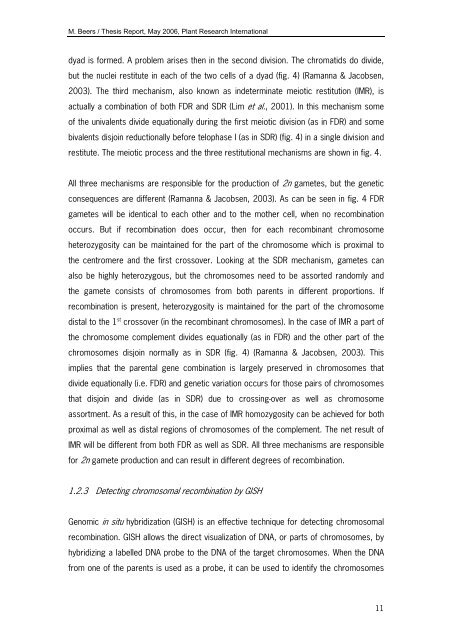Thesis report PRI_Martin Beers_final - The Lilium information page
Thesis report PRI_Martin Beers_final - The Lilium information page
Thesis report PRI_Martin Beers_final - The Lilium information page
Create successful ePaper yourself
Turn your PDF publications into a flip-book with our unique Google optimized e-Paper software.
M. <strong>Beers</strong> / <strong><strong>The</strong>sis</strong> Report, May 2006, Plant Research International<br />
dyad is formed. A problem arises then in the second division. <strong>The</strong> chromatids do divide,<br />
but the nuclei restitute in each of the two cells of a dyad (fig. 4) (Ramanna & Jacobsen,<br />
2003). <strong>The</strong> third mechanism, also known as indeterminate meiotic restitution (IMR), is<br />
actually a combination of both FDR and SDR (Lim et al., 2001). In this mechanism some<br />
of the univalents divide equationally during the first meiotic division (as in FDR) and some<br />
bivalents disjoin reductionally before telophase I (as in SDR) (fig. 4) in a single division and<br />
restitute. <strong>The</strong> meiotic process and the three restitutional mechanisms are shown in fig. 4.<br />
All three mechanisms are responsible for the production of 2n gametes, but the genetic<br />
consequences are different (Ramanna & Jacobsen, 2003). As can be seen in fig. 4 FDR<br />
gametes will be identical to each other and to the mother cell, when no recombination<br />
occurs. But if recombination does occur, then for each recombinant chromosome<br />
heterozygosity can be maintained for the part of the chromosome which is proximal to<br />
the centromere and the first crossover. Looking at the SDR mechanism, gametes can<br />
also be highly heterozygous, but the chromosomes need to be assorted randomly and<br />
the gamete consists of chromosomes from both parents in different proportions. If<br />
recombination is present, heterozygosity is maintained for the part of the chromosome<br />
distal to the 1 st crossover (in the recombinant chromosomes). In the case of IMR a part of<br />
the chromosome complement divides equationally (as in FDR) and the other part of the<br />
chromosomes disjoin normally as in SDR (fig. 4) (Ramanna & Jacobsen, 2003). This<br />
implies that the parental gene combination is largely preserved in chromosomes that<br />
divide equationally (i.e. FDR) and genetic variation occurs for those pairs of chromosomes<br />
that disjoin and divide (as in SDR) due to crossingover as well as chromosome<br />
assortment. As a result of this, in the case of IMR homozygosity can be achieved for both<br />
proximal as well as distal regions of chromosomes of the complement. <strong>The</strong> net result of<br />
IMR will be different from both FDR as well as SDR. All three mechanisms are responsible<br />
for 2n gamete production and can result in different degrees of recombination.<br />
1.2.3 Detecting chromosomal recombination by GISH<br />
Genomic in situ hybridization (GISH) is an effective technique for detecting chromosomal<br />
recombination. GISH allows the direct visualization of DNA, or parts of chromosomes, by<br />
hybridizing a labelled DNA probe to the DNA of the target chromosomes. When the DNA<br />
from one of the parents is used as a probe, it can be used to identify the chromosomes<br />
11














